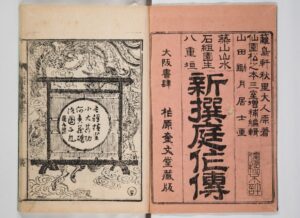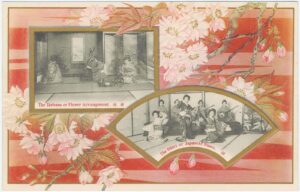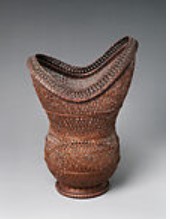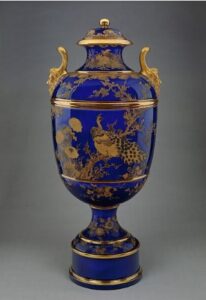The world has been enthralled by the age-old Japanese art of Japanese Ikebana because of its grace, simplicity, and profound connection to nature. Japanese Ikebana is more than just flower arrangement; it’s a contemplative art form that enables its practitioners to express their creativity and discover the beauty of nature via the creative arrangement of flowers, branches, and other natural elements.
History of Japanese Ikebana
Over the years, Japanese Ikebana has changed as a unique art form under the impact of shifting aesthetics, culture, and religion. Its evolution can be linked to several periods in Japanese history and provides insight into the dynamic interplay between nature and humankind.
The Asuka Period (538-710 AD)
Ikebana’s roots can be found in the Asuka period, when Buddhism was initially brought to Japan from Korea and China. Offerings of flowers were made to Buddha and the deceased’s souls as part of Buddhist ceremonies. Known as “tatehana,” these early arrangements were straightforward and emphasised the inherent beauty of flowers.
The Heian Period (794-1185 AD)
Heian times saw the development of Japanese Ikebana into a more complex art form. The indigenous Shinto religion’s love for nature gave rise to the “shintōzu” style. Using flowers and branches arranged in their natural states, this style sought to capture the beauty of nature in its most unadulterated aspect.
The Kamakura Period (1185-1333 AD)
Zen Buddhism gained traction as samurai culture flourished during the Kamakura period. During this period, “nageire,” an austere and methodical approach to Ikebana, came into being. This arrangement technique eschewed the extravagance of previous works in favour of harmony and simplicity, emphasising the spiritual bond between the arranger and the resources.
The Muromachi Period (1336-1573 AD)
Ikebana reached its zenith during the Muromachi era when it became well-liked and acknowledged as a legitimate art form. During this period, the oldest and most esteemed Ikebana school, the Ikenobo school, was founded. Inspired by Japan’s natural landscapes, the school’s founder, Ikenobo Senkei, created the “Rikka” style, which placed an emphasis on structure, balance, and symbolism.
The Edo Period (1603-1868 AD)
Ikebana was made more widely available to everyone throughout the Edo era, including women and commoners. Ikebana saw the emergence of several schools and styles, each with its own distinct methods and philosophy. This period saw the rise in popularity of the “nageire” and “shōka” styles, which highlighted spontaneity and naturalness and sought to capture the essence of a plant in its most beautiful state.
The Meiji Period (1868-1912 AD) and Beyond
Ikebana underwent more development and diversification during the Meiji period as a result of Japan’s modernisation. In the West, the art form gained popularity due to its admirable grace and minimalism. Ikebana is practised now in many different schools and styles across the globe, which represent the rich history and cultural diversity of this age-old art form.
The flower-arranging technique’s timeless beauty and importance are demonstrated by the history of Ikebana. Ikebana has inspired and enthralled people looking for a more intimate relationship with nature and a distinctive way to express themselves artistically, from its modest origins as a religious offering to its present standing as an internationally acclaimed art form.
Illustrated Book of Floral Arrangements in the Mishō Style
For more information you can read this book – Illustrated book of floral arrangements in the Mishō style.
Mishōsai Kōho (1791–1861), the second master of the Mishōstyle of ikebana, or flower arranging, wrote this book of floral designs.

Using Japanese Ikebana in Your Daily Life
Choosing the ideal plants and flowers for your arrangements is one of the simplest ways to start implementing ikebana into your daily life. If you’re not sure where to begin, think about looking via internet resources such as Lily’s Florist. They provide a large selection of lovely plants and flowers that are perfect for Ikebana setups.
Consider the croton plant, for example, if you’re searching for a plant to give your Ikebana designs a hint of elegance. It adds a great pop of colour to any arrangement with its stunning foliage. However, the Expressions of Delight bouquet offers a gorgeous blend of roses and lilies that can be transformed into an Ikebana arrangement if you’d rather have a more conventional floral art.

With its combination of purple and white flowers, the Celestial Passion arrangement is a lovely choice for individuals looking for a more modern and distinctive design. You can play with different styles and techniques by simply disassembling this bouquet and rearranging it in an Ikebana manner.
Use the Tranquilly Basket as the base of your Ikebana arrangement to induce a calm and quiet mood in your house or place of business. This lovely basket is perfect for creating a relaxing atmosphere because it has a variety of green and blooming plants in it.
With its dynamic contour and intersecting-circles plaiting (shippō-ami), this flower basket has an extremely large mouth. It was made in 1965 by Shōkosai V for his debut solo exhibition, which took place at the Mitsukoshi department store in Osaka. It was most likely influenced by an ikebana master’s unusual taste.
The Lilies and Roses Bouquet is a visually arresting combination of flowers that may be skilfully arranged to make a dramatic statement for a more ostentatious Ikebana creation. This bouquet’s combination of hues and textures offers countless opportunities for artistic interpretation.
When you’re prepared to advance your Ikebana skills, think about adding some more exotic options. One such option is the Tropical Spray, which has an exquisite combination of tropical flowers and greenery. This arrangement can be the centre of attention in your house or place of business, encouraging you to experiment with different Ikebana styles and approaches.
Lily’s Florist offers a wide variety of plants, flowers, and arrangements that you can use to create an infinite number of Ikebana patterns that are tailored to your own preferences.
Covered Vase on Plinth
During the late nineteenth century, Trenton, New Jersey served as the hub for the production of fine and commercial grade ceramics in North America. The high-quality hotel ware that Burroughs and Mountford Pottery manufactured in considerable quantities for the national market was their most well-known product. However, the company started producing increasingly complex art pieces in 1892. One of the most ambitious known pieces of American pottery is this enormous covered vase. Like many potteries, the firm’s goal to have a strong showing in the 1893 World’s Columbian Exposition in Chicago provided the push for producing this and a better quality of ceramics.

Said to have been created by a Japanese artist, it features exquisitely detailed raised silver and gold decoration on a rich mazarine-blue background. It is a virtual compilation of Japanesque motifs, which were popular with Western decorative artists in the latter part of the nineteenth century. These motifs include a stylized version of Japanesque clouds, a golden hawk with ducks, a resplendent peacock, peonies, chrysanthemums, and prunus blossoms. The vase evokes excellent porcelains in the Japanese style of Minton’s or Royal Worcester, which were popular with the American audience, as well as Japanese lacquer or Satsuma goods. Impressive when it was created, it was hailed as “a masterpiece of American pottery.”
The Philosophy Behind Ikebana
Ikebana is more than just flower arranging; it’s a deep art form that represents Japanese aesthetics, spirituality, and cultural values. It also incorporates a complex philosophy. Fundamentally, the goal of ikebana is to establish a balanced connection between the artist, the organic materials, and the surrounding area. Ikebana’s aesthetics and practice are informed by a number of fundamental ideas that compose its philosophy.
Wabi-Sabi (one line meaning)
- The Japanese aesthetic and philosophy known as wabi-sabi recognizes beauty in impermanence, imperfection, and simplicity.
- A key idea in Japanese aesthetics is wabi-sabi, which honours the beauty of impermanence, imperfection, and simplicity. Wabi-sabi in ikebana is expressed by appreciating the organic shapes of flowers and branches, even when they appear asymmetrical or imperfect. Ikebana artists create arrangements that capture the fleeting and flawed quality of life by embracing the flaws in every element.
Less Is More
Ikebana emphasises simplicity and the maxim “less is more.” With an emphasis on showcasing the inherent beauty of each individual part, the arrangements are frequently restrained and minimalist. Ikebana artists may achieve a sense of harmony and balance while letting each piece stand out on its own by utilising a small amount of materials.
Ma (example)
The Japanese term “ma” denotes the empty space or negative space that exists between objects. The distance between the flowers and branches in an ikebana piece is equally as significant as the materials themselves. Ikebana artists skilfully arranged the elements to give the composition a sense of depth, movement, and dynamic tension.
For Example, Ikebana and traditional Japanese gardens are Ma.
Connection to Nature
To cultivate a close relationship with nature is one of the main objectives of ikebana. Practitioners develop a sense of thankfulness, reverence, and appreciation for the fragility and beauty of the natural world through working with natural materials. Ikebana also promotes mindfulness and introspection since its practitioners have to pay close attention to and comprehend the particular qualities of each material they deal with.
Spiritual Expression
Ikebana is more than just flower arrangement; it’s a spiritual discipline. It is a self-expression and meditation technique that lets practitioners explore their inner feelings and ideas. Ikebana artists can find inner calm and spiritual fulfilment by building a harmonious arrangement that expresses their mood.
Ikebana philosophy is essentially a reflection of the profound cultural and spiritual values that form the foundation of Japanese civilization. Incorporating the ideas of wabi-sabi, minimalism, ma, spiritual expression, connection to nature, and minimalism, Ikebana practitioners are able to produce exquisite arrangements that are not only aesthetically pleasing but also have deep symbolic value.
Japanese Ikebana Techniques and Styles
Japanese Ikebana has developed over the ages into a broad and varied art form that incorporates many different techniques and aesthetics. Every style has its own distinct concepts, aesthetics, and techniques that give practitioners countless chances to express and explore their creativity.
Rikka
Originating from the Ikenobo school, Rikka is among the most traditional and ancient Ikebana styles. It is distinguished by its intricate, well-organised pattern that resembles a small-scale landscape and includes features like valleys, mountains, and flowing water. In order to provide depth and perspective, Rikka arrangements frequently have a tall core stem or branch around by lower stems and leaves.
Shōka
Another classic form is shōka, which aims to capture the essence of a plant in its most exquisite and unaltered state. Typically, arrangements in this style feature just one or a few varieties of flowers or branches and are more minimalist and restrained than those in the Rikka style. To establish harmony and balance, the shōka style places a strong emphasis on the use of pure, graceful lines and proportions that work well together.
Nageire
Nageire, which translates to “thrown-in” in Japanese, is a more impromptu and unstructured form of Ikebana. It does not rely on rigid rules or systems, but rather highlights the inherent movement and natural beauty of the materials. With an emphasis on encapsulating the vitality and essence of the flowers and branches, nageire arrangements frequently have an asymmetrical and dynamic appearance.
Moribana
The current Ikebana style known as “piled-up flowers,” or moribana, first appeared in the late 1800s. It is distinguished by the use of a broad, shallow container and the addition of a kenzan, a metal holder with spikes for holding the stems in place. In order to give an arrangement a sense of depth and three dimensions, moribana arrangements usually include upright and cascading pieces.
Freestyle Ikebana
Freestyle Ikebana has become a well-liked and cutting-edge method as Ikebana has continued to change and adapt to contemporary tastes. This style allows artists to play around with unusual materials, methods, and configurations, which frequently leads to audacious and creative works that go beyond the bounds of standard Ikebana.
The ultimate goals of Ikebana practice are to express one’s creativity, develop awareness, and establish a connection with nature, regardless of the particular style or technique used. Through the exploration of diverse Ikebana forms and techniques, practitioners can enhance their understanding of the intricacy and beauty of the natural world while also creating their own distinctive artistic voice.
How to Begin Using Ikebana
Starting an Ikebana journey can be a gratifying and thrilling experience. With its profound philosophical foundations, wide range of styles, and rich history, ikebana presents countless chances for artistic expression and personal development. To help you get started with this intriguing art form, consider the following advice:
- Learn the Basics
It’s important to familiarise oneself with the fundamental concepts, methods, and styles of Ikebana before getting started. Learn about the fundamental ideas of Ikebana, such as wabi-sabi, ma, and the relationship to nature, as well as its history and numerous styles.
- Choose Your Materials
Many different types of natural materials, including flowers, branches, leaves, and grasses, can be used to create ikebana arrangements. Think about colour, texture, size, shape, and season when choosing materials for your arrangement. You should also keep in mind the particular style you want to evoke.

- Gather Tools & Supplies
To start learning Ikebana, you’ll need a few basic supplies and tools. These could consist of:
- A container: Ikebana containers are made of many materials, shapes, and sizes. Select one that goes well with the supplies you want to utilise and the look you want to achieve.
- A Kenzan: The metal holder with spikes, called a kenzan, is used to hold the stems of your arrangement in place.
- Clippers or Scissors: Use scissors or clippers to cut and shape your materials as necessary.
- A basin or bucket: This can be used to store your supplies and maintain their freshness as you operate.
1. Study & Practice
Ikebana is a skill that requires practice, just like any other art form. Think about enrolling in a live or virtual class or workshop to pick the brains of seasoned instructors and get practical advice. As an alternative, you can research new methods and sources of inspiration by studying books, guides, and videos.
2. Develop Your Own Style
While mastering the classic Ikebana forms and techniques is crucial, don’t be scared to try new things and come up with your own original style. You’ll be able to use your arrangements to communicate your originality and unique vision as you have more experience and self-assurance.
3. Join a Community
Making connections with other Ikebana fans can be a great way to get encouragement, ideas, and friendship. Think about getting involved in online forums and social media communities devoted to the craft of flower arrangement, or consider joining a local Ikebana group or club.
4. Share Your Work
Sharing your Ikebana artwork on social media, with family, and with friends can be a fulfilling and inspiring experience. You can get criticism, encourage others, and add to the rich and varied world of ikebana by exhibiting your arrangements.
Learning the fundamentals, assembling supplies and equipment, honing techniques, creating your own style, and interacting with like-minded people are all part of getting started with ikebana. You can reap the many benefits of this art form, like enhanced mindfulness, a stronger bond with nature, and a distinctive means of creative expression, by investing time and energy into it.
Benefits of Ikebana
Ikebana is not just a beautiful and sophisticated art form; it also has several advantages that help practitioners grow personally and improve their general well-being. These are a few of the main advantages of practising ikebana:
1. Enhances Mindfulness and Focus
In order to create a harmonious arrangement, ikebana practitioners must carefully examine and control each element, which calls for a great level of concentration and attention to detail. By encouraging practitioners to be in the present, this mindful technique promotes serenity and clarity.
2. Cultivates Creativity and Self-Expression
Ikebana artists can showcase their individual vision and creativity by arranging the pieces in a particular style and using different materials. The artistic medium promotes creativity and exploration while offering a forum for individual expression and development.
3. Promotes Connection to Nature
By utilising organic elements like flowers, branches, and leaves, Ikebana artists cultivate a profound admiration for the intricacy, beauty, and vulnerability of the natural world. A stronger sense of care for the environment and an enhanced understanding of environmental issues might result from this connection to nature.
4. Enhances Spatial Awareness and Aesthetic Sensibility
Ikebana lays a lot of stress on the arrangement’s harmony, symmetry, and proportion as well as the interaction between positive and negative space. People can develop their aesthetic sensibility and spatial awareness through Ikebana practice, which heightens their enjoyment of beauty and design in daily life.
5. Encourages Patience and Perseverance
It can be difficult and time-consuming to create an Ikebana arrangement; it requires tenacity, patience, and a steady hand. Through the mastery of several techniques and styles, practitioners cultivate tenacity and resilience—valuable life skills that they can use in other aspects of their lives.
6. Builds Social Connections
Ikebana can be a social activity that offers chances to interact with other enthusiasts, exchange expertise, and gain information from one another. Taking part in workshops and classes, or even just joining a local Ikebana organisation, can help build community and friendships.
7. Offers Stress Relief and Relaxation
Ikebana is a meditative art form that can be used as a kind of meditation, offering people a peaceful place to decompress. Focussing on the craft of flower arranging allows practitioners to find comfort in the beauty of nature and escape the worries of everyday life.
In conclusion, Ikebana offers advantages that go beyond the arrangements’ visual appeal. This age-old art form can be practised to improve mindfulness, foster creativity, strengthen one’s sense of connection to the natural world, increase spatial awareness, foster patience, foster social interaction, and reduce stress. People can improve their lives and discover the transforming potential of this age-old and enthralling art form by practising ikebana.
Conclusion
Japanese Ikebana is a unique art form that provides a means of expressing creativity, fostering a closer relationship with nature, and deepening one’s understanding of the beauty all around us. You can develop your creative abilities and find a sense of calm and tranquillity by adopting the age-old Japanese technique of floral art.
Japanese Ikebana arrangements may be gorgeous focus pieces or conversation starters for people looking to add a touch of sophistication and elegance to their homes. To further enhance the significance of your Ikebana arrangement, include flowers that have therapeutic properties or design a display honouring unsung female heroes with the best flowers available.
As you learn more about Japanese Ikebana, think about experimenting with different designs and methods. You can also include special components, like succulents or creative planters, to make your arrangements really one-of-a-kind.
The art of Ikebana provides countless opportunities for self-improvement, artistic expression, and a closer relationship with nature, regardless of experience level. You can discover the transformational power of nature and realise your full creative potential by engaging in this age-old activity.

